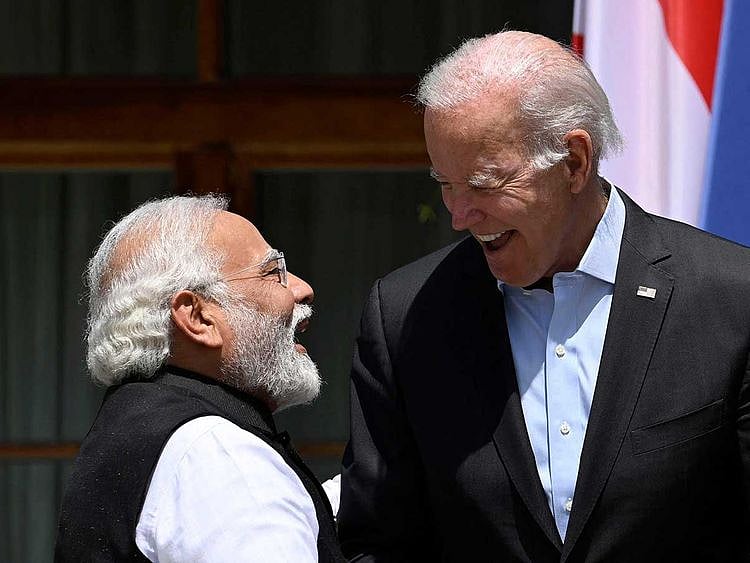Indian Prime Minister Narendra Modi recent triumphant visit to Washington, which featured a state dinner at the White House and a rare second address to a joint session of Congress, appears to mark a new chapter in the relationship between the United States and India following a quarter-century of ups and downs.
Modi’s visit was preceded by several major breakthroughs, including the recent US-India initiative on Critical and Emerging Technology, which seeks to foster bilateral collaboration on technologies such as artificial intelligence, biotechnology, quantum computing, 5G, and cybersecurity. US semiconductor manufacturer Micron Technology recently announced that it plans to invest $825 million in a new chip assembly and testing facility in India.
The US and India have also unveiled several defence agreements, including a deal for India to acquire 30 MQ-9B Predator armed drones from the US and a separate plan to produce F414 fighter jet engines for the Indian Air Force jointly with General Electric. These deals, which have not been previously extended to a country that is not formally an ally, highlight the intensifying bilateral defence partnership.
Also Read
US and India deals: It will be soon easier for Indians to live and work in USBiden, Modi salute ‘defining partnership’ as US invests big in IndiaPhotos: Star-studded state dinner for PM Modi at White houseIndia’s PM Modi brings comedy game to big White House dinner in his honourThe transformation is striking. Throughout the Cold War, the world’s oldest democracy and its largest remained essentially estranged. Historically, India’s non-aligned democracy gravitated toward the secular Soviet Union. Non-alignment was not well-received in the US.
The end of the Cold War, together with the reorientation of India’s foreign policy and its integration into the global economy, led to improvement in US-India relations, but India’s detonation of a nuclear device in 1998 triggered US-led economic sanctions.
An era of bonhomie
President Bill Clinton’s visit to India in 2000, his final year in office, marked a major turning point, and George W. Bush’s administration built on the momentum by signing a defence agreement with India in 2005 and a landmark accord on civil nuclear cooperation in 2008.
The positive trend persisted under both Barack Obama and Donald Trump and now appears to have reached a zenith under President Joe Biden.
While India maintains its independent posture, the recent G7 summit in Hiroshima notably included the second-ever in-person Quad summit between Biden, Modi, Japanese Prime Minister Fumio Kishida, and Australian Prime Minister Anthony Albanese. During the gathering, the four leaders reaffirmed their commitment to a free, open, and inclusive Indo-Pacific.
Pertinently, the US seems much more willing to accommodate India’s postcolonial obsession with strategic autonomy. Whereas Modi stands in stark contrast to his predecessor, Manmohan Singh, there has been remarkable bipartisan support for deepening ties by five successive US presidents and three Indian prime ministers.
The most important factor contributing to the deepening ties between the US and India is the growing number of Indian-Americans, which exceeds four million. Indian-Americans are disproportionately affluent, with the highest median income of any US ethnic group, including whites.
Role of Indian Americans
They are also becoming an increasingly influential voting bloc, and their prominent roles in political fund-raising, on Congressional staffs, and in government offices have given rise to a so-called Samosa Caucus. The US has had two governors and seven members of Congress of Indian heritage.
US Vice President Kamala Harris’s mother is Indian, and Former US Ambassador to the United Nations Nikki Haley — currently running for president — is the daughter of Punjabi Sikh parents.
While their political views vary, many Indian-Americans have been increasingly outspoken on issues related to India. The continuous influx of more than 150,000 Indian students to the US every year contributes to this dynamic.
In addition to injecting nearly $8 billion into the US education system and related services, these migrants ensure a constant infusion of fresh ideas and perspectives. In the long run, Indian-Americans may help shape US policy on India in the same way that Jewish Americans play a role in shaping US policy on Israel.
Modi’s visit was one more indication of how close that cooperation has become.
Project Syndicate
Shashi Tharoor, a former UN under-secretary-general and former Indian Minister of State for External Affairs and Minister of State for Human Resource Development, is an MP for the Indian National Congress. He is the author, most recently, of Ambedkar: A Life (Aleph Book Company, 2022).
Sign up for the Daily Briefing
Get the latest news and updates straight to your inbox
Network Links
GN StoreDownload our app
© Al Nisr Publishing LLC 2025. All rights reserved.
